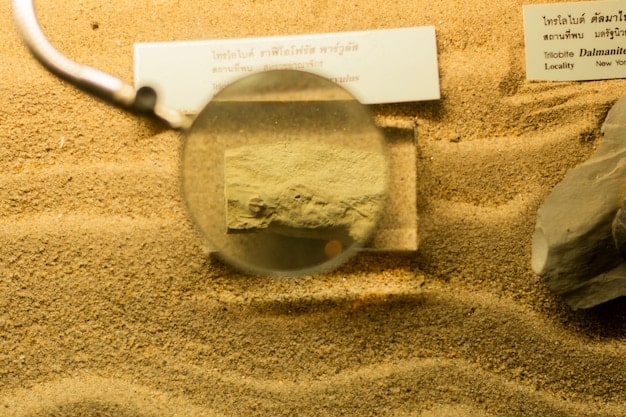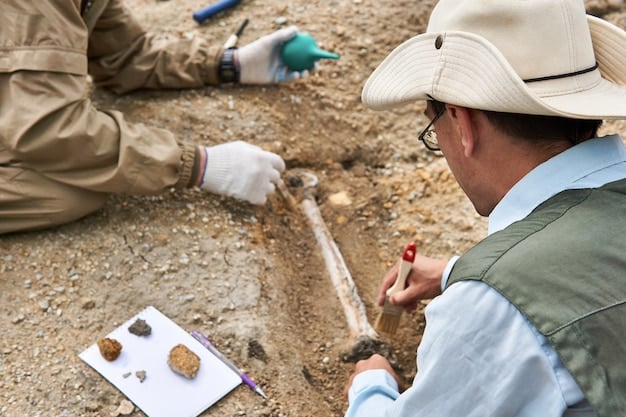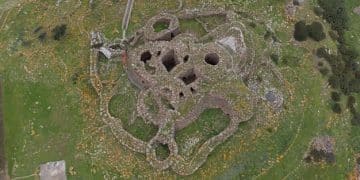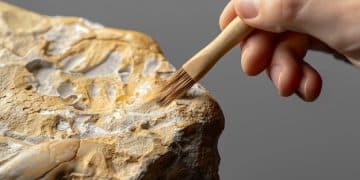Carbon-14 Dating Update: 10% Accuracy Boost Reshapes US Archaeology Timelines

A recent 10% increase in the accuracy of carbon-14 dating methods is significantly reshaping established timelines for key US archaeological sites, prompting a re-evaluation of human migration patterns and cultural developments across the North American continent.
The advancement in Carbon-14 Dating Update: How a 10% Increase in Accuracy is Reshaping Timelines for Key US Archaeological Sites marks a pivotal moment for archaeology. This enhanced precision is not merely a technical refinement; it is fundamentally altering our understanding of ancient human history across the United States.
Understanding Carbon-14 Dating: The Foundational Science
The bedrock of archaeological chronology often rests on carbon-14 dating, a method that has revolutionized our comprehension of the past. At its core, carbon-14 dating relies on the predictable decay of a radioactive isotope of carbon, carbon-14, which is present in all living organisms. When an organism dies, it stops absorbing carbon from the atmosphere, and the carbon-14 within it begins to decay at a known rate. By measuring the remaining carbon-14, scientists can estimate the time elapsed since the organism’s death, thereby providing a chronological framework for archaeological findings.
This technique has been refined considerably since its inception in the late 1940s. Early methods involved gas proportional counting, but modern advancements, particularly Accelerator Mass Spectrometry (AMS), have drastically improved precision. AMS requires much smaller samples and can measure carbon-14 concentrations with greater accuracy, extending the range of dating back tens of thousands of years. The recent 10% increase in accuracy stems from further calibration curve refinements and improved measurement techniques, allowing for more precise distinctions between older and newer samples, especially those nearing the upper limits of the method’s range.
The Half-Life and Calibration Curve
The concept of a half-life is central to carbon-14 dating. Carbon-14 has a half-life of approximately 5,730 years, meaning that after this period, half of the original carbon-14 in a sample will have decayed. While this decay rate is constant, the concentration of carbon-14 in the atmosphere has not been perfectly stable throughout history. Fluctuations in solar activity, Earth’s magnetic field, and cosmic ray intensity can influence atmospheric carbon-14 levels.
- Tree rings provide year-by-year atmospheric carbon-14 concentrations.
- Sediment cores offer long-term records.
- Varves (annual layers in lake sediments) contribute to calibration.
To account for these natural fluctuations, a calibration curve is used. This curve converts raw radiocarbon ages (measured in carbon-14 years) into calendar ages. The precision of this calibration curve is paramount, and ongoing research, often involving dendrochronology (tree-ring dating), has continuously refined it. The latest improvements in accuracy are largely a result of extending and enhancing the resolution of these calibration datasets, particularly for critical periods in human prehistory.
Why a 10% Increase Matters
A 10% increase in accuracy might sound modest, but its implications for archaeological timelines are profound. For sites dating back thousands of years, a 10% improvement can translate into a difference of centuries, potentially shifting the acknowledged dates of key events by significant margins. This enhanced precision allows archaeologists to:
- Distinguish between closely-dated events previously indistinguishable.
- Refine the chronology of cultural changes and innovations.
- More accurately trace migration routes and settlement patterns.
For instance, a site previously dated to a broad window of 500 years might now be narrowed down to 50 years, providing a much clearer picture of its historical context. This level of detail is crucial for understanding the nuances of ancient human behavior and environmental interactions. This improved dating capability is already influencing our interpretations of some of the most significant archaeological sites in the US, allowing for a more granular and reliable understanding of their past.
The continuing efforts to refine carbon-14 dating underscore its enduring importance as a fundamental tool in archaeological research. Every incremental improvement in its accuracy adds another layer of detail and confidence to our reconstruction of the human story.
Revisiting Key US Archaeological Sites with Enhanced Precision
The enhanced precision in carbon-14 dating is catalyzing a major re-evaluation of established chronologies across numerous seminal US archaeological sites. This isn’t about discarding previous work but building upon it with a sharper lens, revealing finer details and even surprising shifts in understanding. Sites previously dated with broad ranges are now being scrutinized with greater temporal resolution, challenging long-held assumptions about their inhabitants, their interactions, and their place in the broader narrative of North American prehistory.
Chaco Culture National Historical Park, New Mexico
Chaco Canyon stands as a monumental center of ancestral Pueblo culture, with its complex architectural marvels like Pueblo Bonito. The previous dating of these structures, largely based on dendrochronology (tree-ring dating) and earlier carbon-14 techniques, placed peak construction and occupation between 850 and 1150 CE. With the new 10% increase in carbon-14 accuracy, researchers are able to:
- Refine construction phases within specific structures, identifying distinct building episodes and potential periods of abandonment or reuse that were previously blurred.
- More precisely date the origin of imported materials, shedding light on the extent and timing of Chaco’s vast trade network.
- Pinpoint climatic events (like droughts) and correlate them more tightly with demographic shifts or changes in site use.
Initial recalibrations suggest that some intensive construction periods might have been shorter and more concentrated than previously thought, hinting at rapid bursts of organized labor. Conversely, other periods of continuous occupation now show more nuanced ebbs and flows, suggesting dynamic responses to environmental and social pressures. This precision offers a more dynamic view of Chacoan society, moving beyond a monolithic interpretation to one of constant adaptation and transformation.
Cahokia Mounds State Historic Site, Illinois
Cahokia, near modern-day St. Louis, was North America’s largest prehistoric city, a thriving Mississippian metropolis with a population potentially exceeding that of London at the time. Its monumental earthen mounds, particularly Monk’s Mound, testify to complex social organization. Previous dating placed Cahokia’s florescence between 1050 and 1200 CE. The increased carbon-14 accuracy is now enabling archaeologists to:
- More accurately date the construction sequences of individual mounds and residential areas, revealing the speed and scale of urban development.
- Distinguish phases of rapid growth versus periods of stagnation or decline, providing insights into the mechanisms of its rise and eventual decline.
- Pinpoint the timing of major feasting events or ritual activities more accurately within the site’s overall chronology.
Early findings from these refined dates are suggesting a potentially more compressed period of rapid core expansion, followed by extended periods of peripheral development and possible shifts in social hierarchy over time. The enhanced accuracy allows for a more detailed understanding of the timeline of its political and social structures, offering clues as to why such a complex urban center eventually dispersed. This deeper chronological insight aids in modeling the factors contributing to the rise and fall of pre-Columbian urban centers.

Meadowcroft Rockshelter, Pennsylvania
Meadowcroft Rockshelter is a critical site for understanding the peopling of the Americas, known for evidence suggesting a pre-Clovis presence. Its deep stratigraphic layers have provided evidence of human occupation dating back possibly 16,000 years, pushing back traditional timelines for human arrival in North America. The new carbon-14 accuracy is particularly transformative for such ancient sites. It allows for:
- Tighter date clusters for the earliest human occupation layers, offering greater confidence in the antiquity of the findings.
- Improved distinction between successive occupational phases, even when separated by relatively short geological periods, refining the understanding of early migration waves.
- More accurate correlation of artifacts with specific environmental conditions of the late Pleistocene.
The 10% increase in precision provides stronger statistical support for the older dates at Meadowcroft, reinforcing its significance as one of the earliest known human habitations in the Americas. This renewed confidence in its chronology influences the wider debate on when and how humans first colonized the continent, potentially solidifying the argument for pre-Clovis settlements. It offers a more robust framework for comparing Meadowcroft’s timeline with other potential early sites across the Americas, contributing to a more complete narrative of early human dispersal.
Impact on Understanding Ancient Migration Patterns
The refined accuracy of carbon-14 dating is proving invaluable in deciphering the complex tapestry of ancient human migration patterns across the Americas. By providing more precise chronological anchors for key archaeological sites, researchers can now trace pathways, assess the timing of dispersal events, and identify potential connections or disconnections between different groups with unprecedented clarity. This improved resolution minimizes the chronological ‘smear’ that previously characterized larger time windows, allowing for more definitive conclusions about the pace and direction of ancient movements.
Rethinking the Peopling of the Americas
The debate surrounding the initial peopling of the Americas is one of archaeology’s most enduring and controversial topics. The traditional “Clovis First” model, positing that the Clovis culture (dated roughly 13,500 to 12,800 years ago) represented the first widespread human presence, has been increasingly challenged by pre-Clovis sites. The enhanced accuracy of carbon-14 dating is playing a crucial role in substantiating these older claims.
- Sites like Meadowcroft Rockshelter (Pennsylvania) and Monte Verde (Chile) are gaining stronger chronological support for their earlier dates, pushing initial human arrival back significantly.
- Newly identified potential pre-Clovis sites can be more rigorously dated, helping to build a more robust, collective body of evidence.
- The refined timelines allow for better integration of archaeological data with genetic studies, which also point to earlier migration waves.
This precision allows archaeologists to examine whether distinct migration waves occurred, at what intervals, and through what routes (e.g., coastal versus interior). It also helps distinguish between isolated earlier incursions and widespread, sustained human presence. The 10% increase in dating accuracy helps to resolve ambiguities that previously made it challenging to definitively categorize sites as pre-Clovis, co-Clovis, or post-Clovis, providing a sharper picture of ancient demography.
Tracking Coastal vs. Inland Movements
For decades, researchers have debated whether early migrants moved primarily along coasts or through interior ice-free corridors. Carbon-14 dating, with its improved accuracy, offers new avenues for investigation.
- More precise dating of coastal shell middens and other resource-rich coastal sites helps to map early maritime adaptations.
- Improved chronological resolution for inland sites assists in understanding the timing of expansion into diverse continental biomes.
- By comparing dates from coastal and inland sites in different regions, archaeologists can infer the relative speed and direction of dispersal.
For example, if highly accurate dates emerge consistently earlier along the Pacific Northwest coast than further inland, it strengthens the argument for an initial coastal migration. Conversely, tightly clustered dates appearing simultaneously across interior regions might point to rapid eastward or southward expansion after an initial continental entry. The enhanced precision allows for stronger correlative analysis between different site types and their geographical distribution, aiding in the reconstruction of dynamic settlement strategies.
Identifying Interaction Spheres and Cultural Diffusion
Beyond initial migrations, the improved accuracy also helps in tracing cultural interactions and the diffusion of technologies or ideas. If two sites, separated by vast distances, show the introduction of a similar artifact type within a very narrow, precisely dated timeframe, it strongly suggests a rapid spread of information or direct interaction. This refined chronological resolution empowers archaeologists to:
- Map the expansion of specific tool technologies (e.g., specialized projectile points) with greater accuracy.
- Identify periods of increased inter-group trade or conflict by correlating artifacts with their precise temporal context.
- Understand the speed at which agricultural practices or sedentary lifestyles spread across different regions.
The ability to distinguish between events separated by a century or less, where previously they might have appeared simultaneous within a broader estimation, is game-changing. This allows for a more nuanced understanding of how ancient societies interacted and influenced one another, moving beyond broad generalizations to more specific case studies of cultural exchange and adaptation. Ultimately, the more precise timelines are allowing for a more accurate and vivid reconstruction of ancient US history.
Challenges and Nuances in Interpreting New Radiocarbon Data
While the 10% increase in carbon-14 dating accuracy presents exciting opportunities, it also introduces new layers of complexity and demands careful, nuanced interpretation. The enhanced precision requires archaeologists to be even more vigilant about potential pitfalls and contextual factors that can influence dating results. It’s not simply a matter of plugging in new numbers; it’s about integrating these refined dates into a broader understanding of the archaeological record, which includes stratigraphy, artifact analysis, and environmental data.
Contamination and Sample Integrity
One of the most persistent challenges in radiocarbon dating is sample contamination. Even with more precise measurement techniques, if the sample itself is compromised, the results will be inaccurate.
- Modern carbon (e.g., from handling, preservatives) can make old samples appear younger.
- Old carbon (e.g., from limestone, groundwater) can make young samples appear older.
- Root intrusion, animal burrowing, and post-depositional disturbance can mix archaeological layers, leading to misleading dates.
The very precision of the new method accentuates the impact of even minor contamination. A 10% error on a 10,000-year-old sample is significantly more impactful than on a 1,000-year-old one. Archaeologists must implement rigorous collection protocols, meticulous laboratory preparation, and stringent quality control measures to minimize these risks. Recalibrating dates means constantly questioning if the sample truly represents the event being dated, or if it has been affected by its environment.
Plateaus in the Calibration Curve
The radiocarbon calibration curve, while refined, is not perfectly linear. There are periods, known as “plateaus,” where the atmospheric carbon-14 concentration remained relatively stable for extended durations. During these plateaus, multiple calendar dates can correspond to the same radiocarbon age, making it difficult to pinpoint exact chronology.
- A single radiocarbon date may correspond to a window of several centuries, even with high precision.
- Multiple dates from the same archaeological layer can help narrow uncertainties.
- Cross-referencing with other dating methods (e.g., dendrochronology, archaeomagnetic dating) becomes critically important during plateau periods.
The increased accuracy can help to resolve some of these ambiguities by making the “wobbles” within plateaus more discernible, but it does not eliminate the problem entirely. Interpreting dates that fall within these plateaus requires a more probabilistic approach and reliance on a suite of dating techniques for robust chronological frameworks. Archaeologists must be transparent about these uncertainties in their interpretations, presenting ranges rather than single points when appropriate.
The Reservoir Effect and Marine Samples
A particular challenge arises with the “reservoir effect,” especially when dating marine or aquatic organisms. Organisms living in water bodies can incorporate “old” carbon from dissolved carbonates or deep ocean waters that may have been isolated from atmospheric carbon for extended periods. This makes them appear older than they actually are.
- Marine organisms can yield dates hundreds to over a thousand years older than their true age.
- Specific regional marine reservoir corrections (ΔR values) are applied, but these can vary and introduce uncertainty.
- Dating human remains that consumed marine diets requires careful consideration and correction.
The 10% increase in accuracy means that applying incorrect or imprecise reservoir corrections can lead to significant chronological errors. Researchers must carefully understand the dietary habits of ancient populations and the local marine environment when interpreting dates derived from marine shells, fish bones, or human remains with aquatic diets. This highlights the need for interdisciplinary collaboration between archaeologists, oceanographers, and geochemists to develop more precise regional corrections. The nuances of dating require a holistic approach, where scientific improvements are weighed alongside the complex realities of archaeological context.
Reshaping Pre-Columbian Narratives and Cultural Timelines
The enhanced accuracy in carbon-14 dating is not merely adjusting numbers; it is fundamentally reforming our understanding of pre-Columbian narratives across the United States. By providing sharper chronological distinctions, archaeologists can now develop more precise timelines for cultural developments, technological innovations, and the rise and fall of ancient societies. This precision helps move away from broad generalizations towards a more nuanced and dynamic portrayal of complex indigenous histories, allowing for a re-evaluation of long-held assumptions and the emergence of new insights into ancient life.
The Emergence of Agriculture and Sedentary Lifeways
The transition from nomadic foraging to settled agricultural communities was a pivotal shift in human history. Pinpointing the exact timing of this transition in different regions of the US is crucial for understanding its spread and impact. With increased carbon-14 accuracy, archaeologists can now:
- More precisely date the earliest evidence of domesticated plants (e.g., maize, squash) in specific regions, such as the Southwest or Eastern Woodlands.
- Distinguish between initial experimentation with plant cultivation and widespread adoption of agricultural practices.
- Correlate the emergence of agriculture with the development of more permanent settlements and changes in social organization.
For instance, in the US Southwest, where early maize dates are critical, a 10% accuracy increase can refine when particular varieties of corn arrived and how quickly they spread, supporting or refuting theories about its dispersal routes from Mexico. This allows for a more detailed understanding of the dynamic interactions between environmental factors, technological innovations, and human decision-making that led to agricultural societies. It provides granular data for modeling how and why sedentary lifestyles took root in various ancient American cultures.
Tracking Technological Innovations and Diffusion
The spread of new technologies—from pottery styles to projectile point designs—provides invaluable clues about cultural contact, trade networks, and independent invention. The ability to date these innovations more precisely allows for better mapping of their diffusion.
- More accurate dating of the earliest pottery fragments helps trace the independent invention or spread of ceramic technology.
- Refined chronologies for specific projectile point types allow archaeologists to understand their distribution patterns and associated cultural groups.
- Insights into the simultaneous or sequential emergence of complex architectural techniques.
For example, if a specific pottery style appears at two distant sites with highly precise, near-simultaneous dates, it points to rapid diffusion or strong interconnectivity. Conversely, if there’s a clear time lag, it suggests a slower, step-by-step spread. This precision helps to resolve debates about whether certain innovations were homegrown or introduced, fostering a richer understanding of the dynamic interplay between different ancient cultures across the North American landscape.

Revisiting Cultural Interactions and Conflicts
Chronological precision is paramount for understanding inter-group dynamics, including periods of interaction, trade, and even conflict. When events can be dated within a much narrower window, it becomes possible to reconstruct dynamic relationships more confidently.
- Identifying periods of intensive exchange by dating trade goods and their associated contexts.
- More accurately dating destructive events like fires or fortifications that could indicate conflict episodes.
- Correlating population aggregation or dispersal with specific calendrical events or environmental stressors.
For Southwestern archaeology, for instance, a refined timeline could illuminate the precise phasing of interactions between Pueblo groups and incoming Athapaskan-speaking peoples, distinguishing between early encounters and later more sustained relationships. By providing a more resolute timeline, the increased accuracy helps to deconstruct the complex narratives of ancient US societies, moving beyond speculative connections to evidence-based interpretations of cultural evolution and interaction. It enables archaeologists to tell more compelling and fact-driven stories about the human past.
The Future of Archaeological Research and Interdisciplinary Collaboration
The 10% increase in carbon-14 dating accuracy is not just a technological upgrade; it signals a new era for archaeological research, one characterized by even greater precision, richer interdisciplinary collaboration, and a holistic approach to understanding the past. This enhancement reinforces the need for closer ties between laboratories and field sites, ensuring that archaeological context is meticulously maintained alongside advanced scientific analysis. The future of the field will increasingly rely on integrating these high-resolution chronologies with other scientific advancements.
Integrating with Other High-Resolution Dating Techniques
While carbon-14 remains a cornerstone, its increased accuracy amplifies the benefits of integrating it with other high-resolution dating methods. No single dating technique is perfect, and combining them strengthens chronological frameworks.
- Dendrochronology: Provides annual precision and helps calibrate the carbon-14 curve, especially for younger sites. The new carbon-14 accuracy demands even more precise tree-ring chronologies for comparison.
- Archaeomagnetic Dating: Uses changes in Earth’s magnetic field over time. When used with precise carbon-14, it can help anchor floating archaeomagnetic curves and provide cross-checks.
- Luminescence Dating (OSL/TL): Dates the last exposure of minerals to sunlight or heat, crucial for non-organic materials and very old sediments. The refined carbon-14 helps bridge the gap with older timeframes.
This multi-method approach ensures robust timelines, mitigating the limitations of any single technique and allowing archaeologists to tackle more complex chronological questions. For sites in the US, where complex multi-period occupations are common, such integrated dating strategies are invaluable for disentangling overlapping layers of human activity. The synergy between precise carbon-14 and complementary methods creates a far more reliable time scale for archaeological interpretation.
Broader Implications for Paleoclimatology and Environmental History
Human history is inextricably linked with environmental change. More accurate carbon-14 dating allows for more precise correlations between archaeological events and paleoclimatic records.
- Pinpointing the impact of droughts or periods of increased rainfall on ancient settlement patterns and subsistence strategies.
- Correlating the timing of human migration or cultural collapse with known climate shifts documented in ice cores, lake sediments, or ocean records.
- Understanding the long-term human impact on ancient landscapes and ecosystems.
For example, if a severe drought documented in tree-ring data can be precisely correlated with a period of abandonment at a US archaeological site using refined carbon-14 dates, it strengthens the argument for environmental stress as a causal factor. This level of chronological precision fosters a more holistic understanding of human-environment interactions throughout prehistory. It allows researchers to move beyond general correlations to specific, finely tuned analyses of how environmental forces shaped ancient human societies.
Future Research Directions
The continually improving precision of carbon-14 dating encourages archaeologists to ask new, more detailed questions about the past.
- Micro-Chronologies: Focusing on very short-term events or processes, such as individual feasting episodes, rapid construction phases, or single seasons of occupation within complex sites.
- Human-Animal Interactions: More accurately dating animal bones associated with human activity can refine our understanding of ancient hunting practices, domestication, and human impact on faunal populations.
- Bioarchaeology and Paleogenomics: Linking precise dates of human remains with ancient DNA analysis can provide unparalleled insights into population movements, genetic diversity, and ancient epidemiology.
The 10% improvement in accuracy is a stepping stone. Future advancements in dating technology, coupled with sophisticated statistical modeling and computational power, promise even greater refinement. This trajectory underscores the dynamic nature of archaeology, where scientific breakthroughs continually reshape our understanding of the human past, making it an ever-evolving field of discovery. Continuous investment in scientific dating techniques and their application is paramount for generating new insights into North America’s rich pre-Columbian heritage.
| Key Aspect | Brief Description |
|---|---|
| 🧪 Carbon-14 Accuracy | A 10% increase in radiometric precision is refining archaeological timelines significantly. |
| ⏱️ Reshaping Timelines | Major US sites like Chaco and Cahokia are seeing their chronologies refined by centuries or decades. |
| 🌎 Migration Patterns | Offers clearer insights into the initial peopling of the Americas and subsequent dispersals. |
| 🤝 Interdisciplinary Focus | Promotes stronger collaboration between dating labs, field archaeologists, and other specialists to optimize results. |
Frequently Asked Questions
It signifies a significant reduction in the margin of error for age estimates. For example, a site previously dated with a +/- 100-year window might now be refined to +/- 90 years. This enhanced precision allows for sharper distinctions between closely spaced events and offers more reliable chronological data, particularly for older archaeological contexts where small percentage errors can translate into large time differences.
The refined accuracy allows archaeologists to precisely map cultural shifts, construction phases, and periods of occupation at sites like Chaco Canyon and Cahokia Mounds. It provides tighter chronological controls, enabling a more nuanced understanding of ancient migration patterns, technological diffusion, and the complex societal developments of pre-Columbian indigenous cultures across the continent, revealing a more detailed and accurate historical narrative.
No, carbon-14 dating is a crucial tool, but archaeologists often employ multiple dating techniques for a comprehensive chronological framework. These include dendrochronology (tree-ring dating), archaeomagnetic dating (based on Earth’s magnetic field), and luminescence dating (for minerals). Combining these methods helps cross-validate results and overcome the limitations inherent in any single technique, leading to more robust and reliable timelines for archaeological contexts.
Despite the increased precision, challenges include sample contamination, which can skew results, and the presence of “plateaus” in the calibration curve where multiple calendar dates correspond to a single radiocarbon age. The “reservoir effect” in aquatic samples also requires careful correction. Archaeologists must meticulously manage sample integrity and combine carbon-14 data with other methods and contextual information to ensure accurate interpretations.
This increased accuracy provides stronger chronological support for earlier, pre-Clovis sites like Meadowcroft Rockshelter, challenging the long-held “Clovis First” model. It allows researchers to more accurately differentiate between distinct waves of migration and trace potential coastal or interior routes. The refined timelines offer clearer insights into when and how ancient populations dispersed across the continent, enriching the complex narrative of the earliest human presence in the Western Hemisphere.
Conclusion
The recent 10% increase in the accuracy of carbon-14 dating represents a quiet revolution in archaeology, fundamentally altering how we perceive and interpret the deep history of human habitation across the United States. This enhanced precision is not merely a statistical refinement; it is a catalyst for reshaping ancient timelines, providing archaeologists with an unprecedented ability to pinpoint critical moments in pre-Columbian cultures. From the grand urban centers of Cahokia to the enigmatic structures of Chaco Canyon and the earliest human traces at Meadowcroft Rockshelter, sites are being re-evaluated with a sharper chronological lens, allowing for more nuanced narratives about migration patterns, technological diffusion, and societal evolution. As this scientific tool continues to advance, fostering deeper interdisciplinary collaboration, the stories embedded in America’s archaeological record will undoubtedly become even richer and more vividly detailed.





